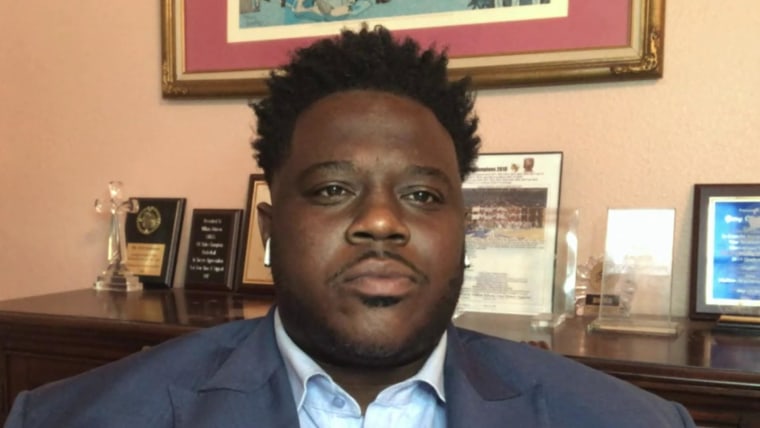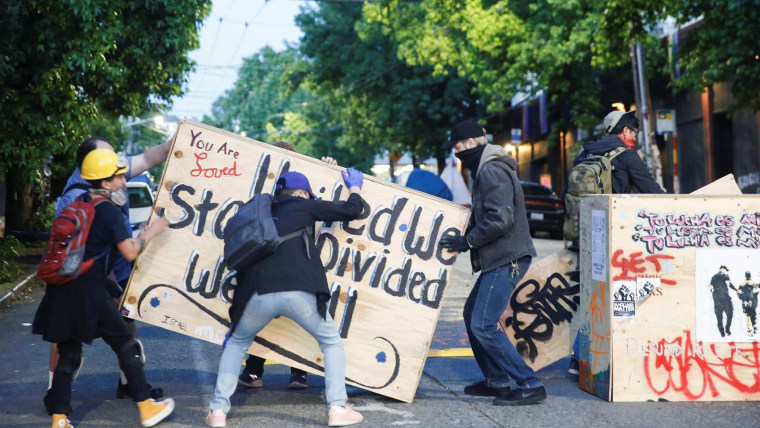Gary Chambers Jr. did not expect the Instagram post of his confrontation with a white school board member to go viral.
Chambers, a racial justice activist in Baton Rouge, Louisiana, excoriated the board member for online shopping during a recent debate over the name of Lee Magnet High School, which is named for the Confederate General Robert E. Lee. But Chambers didn’t share the video on his Twitter account. Instead, he posted it to Instagram, where his account had 26,000 followers at the time.
The video has topped 1.8 million views since he posted it on Juneteenth, and his Instagram videos now regularly garner tens of thousands of views.
“What it speaks to is that this video is hitting people in their core, that they are feeling something when they see this,” he said. “That speaks to where I think we are as a country.”
Chambers now has nearly 200,000 followers on the platform, an increase that he believes points to the demand for visual messages on social justice issues after the death of George Floyd.
“The revolution may not be televised,” Chambers said. “But they ain’t said nothing about social media.”
Chambers is one of many activists who have found sudden success on Instagram, a social media platform more often associated with lifestyle influencers than social justice organizers. Over the past month, however, Instagram has become a crucial tool to organize and educate people around police reform and anti-racism, all while Facebook, its parent company, faces the loss of advertisers and mounting criticism for hosting hate speech.
Activists who spoke with NBC News said Instagram provides an important dynamic for their efforts: a young audience that is receptive to social justice issues on a flexible medium for sharing content. Some use it to educate viewers on policy and candidates while others broadcast protesting experiences and strategize about where the movement goes next — sometimes literally, as they provide live updates on protests and marches.
“People talk about Malcom X and Dr. King all the time — they would use the hell out of these platforms if they had them,” Chambers said. “They would maximize them to the fullest because a big part of their work was to expose the world to what was happening.”
The shift highlights the importance of visuals in recent social movements, according to Paolo Gerbaudo, author of “Tweets and the Streets: Social Media and Contemporary Activism” and a senior lecturer at King’s College London. Visualizing information is crucial to creating a clear and authentic narrative for people to emotionally invest in, he said. It’s something Instagram was made for.
“That’s precisely the step that is facilitated by things such as memes, jargon, slogans, pictures,” Gerbaudo said. “It’s a war of symbols that is, by all means, as important as the war on the ground.”
The appeal of Instagram
Etienne Maurice, a filmmaker in Los Angeles, wants to make sure people can “hear and see” how Black people feel.
To that end, Maurice uses Instagram to post videos and host town halls. Viewed by thousands, his posts are driven by his belief that people must protest both in the streets and on social media so those in positions of power are forced to contend with Black experiences and trauma.
“Some people may not understand where we come from,” he said. “And the only way that people will understand is if we’re able to articulate these feelings and be able to get someone to empathize with those feelings.”
That’s not easy, particularly on social media platforms that are often crowded with all manner of content. While Facebook remains a major platform for organizing events and Twitter drives news cycles, Instagram offers a more personal, culture-focused sensibility. Already during the coronavirus pandemic, the platform has become a popular destination for celebrities to connect with fans and others to lend a helping hand.
Instagram’s most visible use in the recent protests came in the form of a single-day blackout that was widely embraced but also panned as slacktivism, the support of a cause on social media without the intention of additional effort. But even as protests have begun to dwindle, organizers have found a way to maintain momentum on the platform.
Livia Rose Johnson — a college student and member of Warriors in the Garden, a group in New York City that has led thousands of people in marches across the city — said that as protests diminish, her group is beginning to lean on digital organizing with an emphasis on educating viewers on public policy, politics, colorism, race and allyism.
They’ve been successful, Johnson said, because they have had a major presence in the streets and on Instagram, where they’ve found that Generation Z kids are suddenly hungry to learn about social inequities.
“This is the best way to educate people,” Johnson said of Instagram. “We need to educate people in media, so that the content they see is fun, it’s relatable, but it’s also educational and teaches people about their rights and teaches Black people about how to prosper.”
Older organizers are also pivoting to Instagram to explain the movement to young audiences. Marcus Coleman is one of them: He said when he began his activism in Atlanta nearly 15 years ago, it was relatively difficult to pull a group together. But today, he’s adapting his methods for a new generation.
Now he’s reveling in the ease of social media, using it to spread his message and event information online. He’s also navigating which topics work for each platform, noting that Facebook engagement is higher on subjects like Black fatherhood, while on Instagram there’s a younger audience that shows more interest in broader facts about racial injustice.
“Honestly, I know my place at this point in time, and I consider myself and others like me a ‘bridge,’ those who have the stamp of the living legends, especially here in Atlanta,” he said. “It’s just being that bridge between the youth and the elders and really trying to strengthen this intergenerational movement that we see now.”
Instagram and other social media platforms aren’t just being used as means to spread a message. They’re also often platforms for strategy, logistics and fundraising.
Organizers in cities such as New York and Los Angeles use centralized Instagram accounts — @justiceforgeorgenyc and @inthistogether_la — to track marches and vigils across their cities in real time. Both have garnered hundreds of thousands of followers in mere weeks.
Groups like Warriors in the Garden, Black Lives Matter Greater New York and Freedom March NYC send plans and updates to volunteers who run the main New York City account, which now boasts 221,000 followers since it was started about a month ago. The manager of @justiceforgeorgenyc declined to comment, stating in an email they were focused on “the needs and goals of the organizers we’re talking to and the movement as a whole.”
While digital activism gains national momentum, experts and activists warn against slacktivist measures of joining the cause, like the viral #BlackoutTuesday movement earlier this month, which can mute conversations about strategy and logistics. But even viral trends have proven to lead to an uptick in online fundraising efforts.
Instagram has been a boon for fundraising across the board, as activists use it to announce and share campaigns to raise money via services such as Venmo and Cash App. Movers and Shakers NYC raised $10,000 to buy 12,000 KN95 masks for Black Lives Matter protesters this month, while Freedom March NYC raised over $55,000 to buy supplies, train organizers and further establish itself as a social justice organization.
New groups and individual organizers regularly promote their own mobile payment accounts in their Instagram bios, posts and stories.
It appears to be paying off. One group that began its attempt to occupy City Hall in New York City on Tuesday, the same day it started its Instagram account, raised more than $15,000 via small donations within 24 hours almost solely through Instagram promotion and the help of @justiceforgeorgenyc.
“I feel like [@justiceforgeorgenyc] and Warriors in the Garden are trying to do a similar thing, where it’s developing the Black community,” said Johnson, who has been among the occupiers. “Our goal is to create a digital community that can help create a prosperous physical one.”













